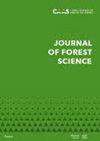北方森林连续覆盖森林的试点研究:剩余树木是否影响货代生产力?
IF 1.1
Q3 FORESTRY
引用次数: 0
摘要
:根据文献,转发生产率主要取决于日志浓度、分类数、平均日志体积、负载大小、斜率和提取距离。然而,关于北方森林连续覆盖林(CCF)的转发,以及剩余树木的存在是否真的影响转发生产力的科学知识并不多。因此,我们研究的目的是分离CCF期间剩余树木(即林分密度)对转发生产力的影响,特别是选择砍伐。结果表明,对生产率的影响主要由对数浓度来解释,其他因素的影响最小。最重要的是,在其他条件相同的情况下,林分密度对林分生产力的影响不显著。因此,我们得出结论,剩余树木不影响北方森林的转发生产力。虽然CCF操作的研究结果只能谨慎地应用于平均年龄的森林,但我们的结果提出了一个普遍的问题:如果剩余树木(林分密度)不影响转发生产力,我们是否需要单独的生产力模型来研究北方森林的间伐和砍伐操作?由于数据集较小,我们认为我们的论文是一项试点研究,其发现需要通过基于更大数据集的研究来验证,包括几个运营商和展台。本文章由计算机程序翻译,如有差异,请以英文原文为准。
A pilot study of continuous cover forestry in boreal forests: Do remaining trees affect forwarder productivity?
: According to the literature, forwarding productivity depends chiefly on log concentration, the number of as-sortments, mean log volume, load-size, slope, and extraction distance. However, there is not much scientific knowledge available on forwarding in continuous cover forestry (CCF) in boreal forests, nor whether the presence of remaining trees actually affects forwarding productivity. Thus, the objective of our study was to isolate the effect of remaining trees (i.e. stand density) on forwarding productivity during CCF, specifically selection cutting. The results showed that productivity was explained mainly by the log concentration, while other factors had at most minor effects. Most importantly, stand density did not significantly affect forwarding productivity, ceteris paribus . Thus, we conclude that remaining trees do not affect forwarding productivity in boreal forests. Although the study results from this CCF operation must only be cautiously applied to even-aged forestry, our results raise a general question: do we need separate productivity models for thinning and clearcut operations in boreal forests if remaining trees (stand density) do not affect forwarding productivity? Because of the small dataset, we consider our paper to be a pilot study whose findings need to be verified by studies based on larger datasets including several operators and stands.
求助全文
通过发布文献求助,成功后即可免费获取论文全文。
去求助
来源期刊

Journal of forest science
Forestry-
CiteScore
2.30
自引率
9.10%
发文量
48
审稿时长
6 weeks
期刊介绍:
Original results of basic and applied research from all fields of forestry related to European forest ecosystems and their functions including those in the landscape and wood production chain are published in original scientific papers, short communications and review articles. Papers are published in English
 求助内容:
求助内容: 应助结果提醒方式:
应助结果提醒方式:


